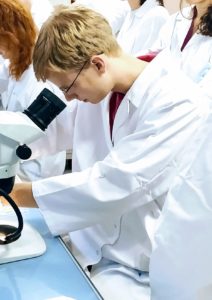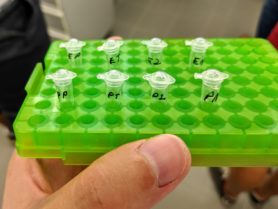Blogpost
IBPS Summer School on Endocrine Disruptors 2019
By: John Hader, ESR 6, Exposure Work Package (WP4)

Cocktail hour on the top floor of a tower on campus provided what is rumored to be one of the best views of Paris
From August 25th to 31st, I had the opportunity to attend the first ever Institut de Biologie Paris-Seine (IBPS) Summer School on Endocrine Disruptors. The course was held at the Pierre and Marie Curie Campus of Sorbonne Université in the Latin Quarter of Paris. This five day course (conducted by experts in the field from the University, the Muséum National d’Histoire Naturelle, the French Agency for Food, Environmental and Occupational Health Safety, and other French research institutions) introduced 16 PhD students and postdocs to a wide range of topics in endocrine disruptor research. In addition to lectures on the history, theory, monitoring, effect analysis, and regulation of endocrine disrupting chemicals, a significant part of the course was devoted to giving us attendees hands-on experience with the research methods used by the invited lecturers.
This involved an excellent mix of both computer-based methods (like statistical analyses of metabolic pathways and image processing of various biological samples) as well as experimental lab work like conducting a PCR analysis to detect a specific gene in an insect model and fluorescence imaging of tadpoles to investigate the impact of an endocrine disrupting chemical.
Throughout the course, we had thought-provoking discussions on the following topics:
- The current state of endocrine disruption research, how these chemicals are defined and identified, and how they are regulated.
- The fact that there has been an unexplained increase in neurodevelopmental diseases correlated with an increasing number of chemicals produced by humans.
- How endocrine disrupting chemicals impact organisms differently based on their age of development at the time of exposure, and the peculiar non-monotonic exposure-response curve that endocrine disrupting chemicals can cause.
- How endocrine disruptors are handled under current European chemical regulations (e.g., REACH) and some of the uncertainties and issues involved with current regulatory procedures.
- The crucial role that in vivo studies play in endocrine disrupting chemical detection and hazard identification.
- Current methods of and issues involved with human biomonitoring of endocrine disrupting chemicals.
- Some of the work that goes into attempting to measure the quantitative and qualitative impacts of endocrine disrupting chemicals on society.

John adjusting the positions of tadpoles in well plates prior to fluorescence imaging (photo credit IBPS)
One of the big takeaways from the course for me was that the endocrine system is not only a very sensitive biological system, but that its disruption by exposure to endocrine disrupting chemicals in the environment can have truly profound effects on individual organisms and the population as a whole. Particularly interesting is the fact that the timing of exposure to endocrine disrupting chemicals in the developmental progress of organisms plays a critical role in the impacts that this exposure can have. This has very interesting implications from an exposure modeling perspective (which is my role within the ECORISK2050 project)
I felt very fortunate to have been accepted into this enriching short course. Besides the fact that the material was fascinating and presented in a highly engaging way, it was enlightening to be able to discuss the state of the science with experts in the field, and also get a hands-on demonstration of the difficulties and uncertainties associated with developing chemical hazard information that, as a modeler, I can often take for granted.
- Since it was Paris, of course the inside of the University looked more like an art museum
- Guided tour of The Grand Gallery of Evolution
- Classes during the day, exploration of Paris at night

 This project received funding
from the EU Horizon 2020 program
under Marie Sklodowska-Curie
grant agreement No 813124
This project received funding
from the EU Horizon 2020 program
under Marie Sklodowska-Curie
grant agreement No 813124


